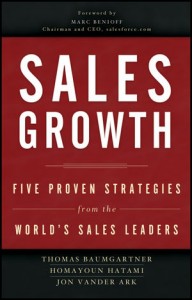 This week’s book recommendation is Sales Growth: Five Proven Strategies from the World’s Sales Leaders
This week’s book recommendation is Sales Growth: Five Proven Strategies from the World’s Sales Leaders, by McKinsey and Company partners Thomas Baumgartner, Homayoun Hatami and Jon Vander Ark.
With a few exceptions, you may not find a lot of jaw-dropping revelations in the book, but it’s well worth reading for the three important services it provides for sales leaders and for the profession of sales:
First, it provides a template of best practices being used by some top sales organizations. They interviewed 120 sales executives from 100 large companies in 10 industry sectors that have “significantly outperformed their peers”. Although this is far short of gold standard for research methods, it’s far better than many similar sales books (and business books in general) that claim to have found the secrets to success, so their prescriptions are worth reading. The five strategies are:
- Find growth before your competitors do
- Sell the way your customers want
- Soup up your sales engine
- Focus on your people
- Lead sales growth
Each strategy is further broken down into specific practices, and support for their success is provided statistically and anecdotally. They are summarized in a table at the end of the book which compares “good” to “great” practices; in my opinion, the eight pages from 207-214 are more than worth the price of the book and should be taped up in the offices of every sales executive. While few of the strategies will be a revelation to any sales professional, I’d venture to guess that no one is firing on all cylinders on more than one or two.
Second, the book reinforces a growing and welcome trend toward moving sales from an art to a science, by putting data at the heart of it. If we want sales to be more professional and a more respected aspect of business, we’ve got to become more data-driven. In fact, one of the relatively new topics covered in the book is the use of Big Data to support several of the five strategies, and we’re going to see much more about this in the near future. There are several good examples of companies using it to look beyond averages to identify opportunities at a much more granular level, to gain insights from social media, an—most importantly—to provide actionable insights to individual salespeople. As the data crunchers get better at doing the latter, you’re going to see much more demand for it from the field.
Finally, if you’ve ever had the frustrating experience of vainly trying to get your message across to top management, only to have them jump on it when a prestigious consultant says it, you will appreciate the third service provided by Sales Growth. It’s hard to have a more prestigious mouthpiece than McKinsey in your corner. So, if you’re a sales leader and have been trying to get more resources or attention for some of your sales initiatives, make sure a copy of this book finds its way to your executive suite.





